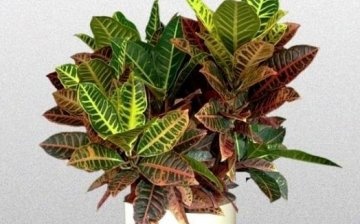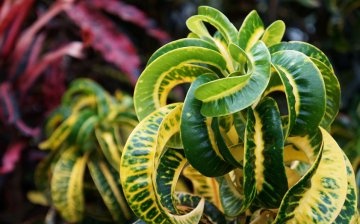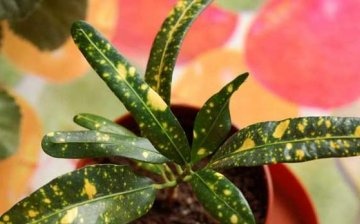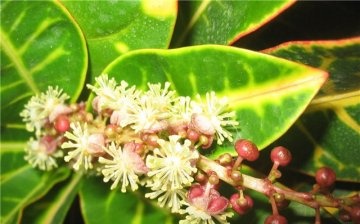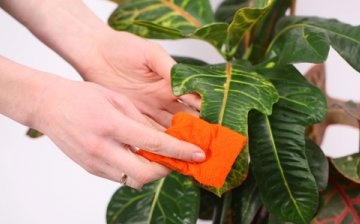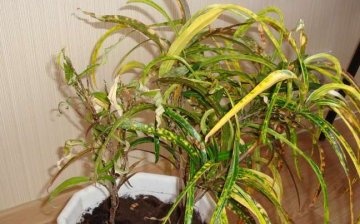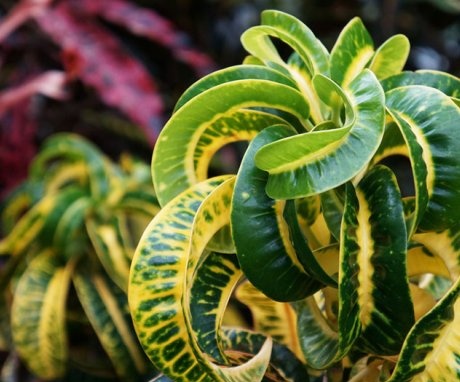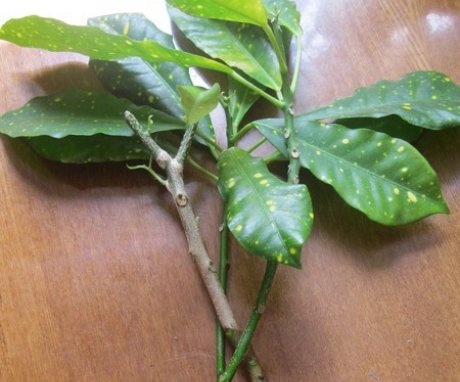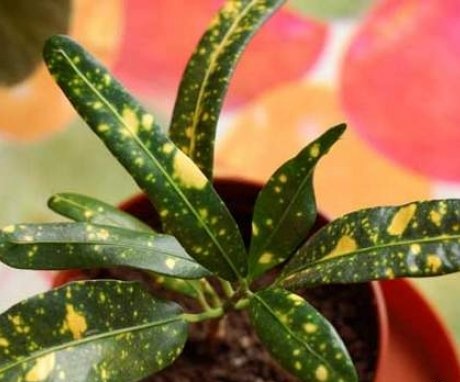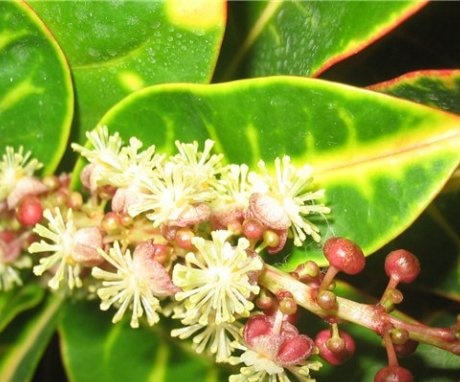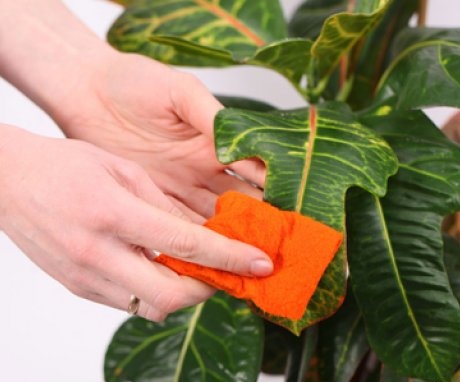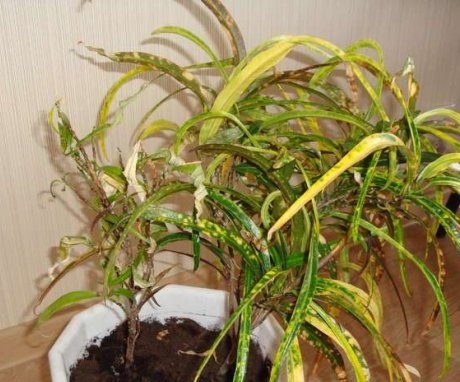Motley codiaum: simple cultivation of a handsome indoor man
Codiaums (often mistakenly called crotons) are beautiful indoor plants with large, wide leaves. Their special charm is given by the color of the leaves - spots and lines of reddish, yellow color. In nature, codiaums grow in India and Southeast Asia. Florists grow at home only one species of this tropical plant is variegated codiaum, which is very popular with flower lovers.
Content:
- Indoor plant description
- Propagation by cuttings
- Propagation by air layers
- Seed propagation
- Correct care
- Diseases and pests
Indoor plant description
The representative of the euphorbia family, codiaum, belongs to the evergreen shrubs... The plant gained its fame because of the amazingly beautiful shiny leaves, which, depending on the type of codiaum, can be of different shapes and colors. It is impossible to find two absolutely identical leaves on one plant.
Leaves are green, burgundy with yellow, red, orange veins.
In young codiaeums, the leaves are usually lighter, with age they change color to dark and become burgundy or reddish. Period flowering codiaum - summer, inflorescences do not look very attractive. When blooming, it is recommended to pick them off, since the flowers consume a lot of nutrients that the plant itself does not get.
Codiaum is a dioecious plant, and flowers of different sexes differ in structure: women have no petals, men have a calyx and a corolla.
Breeding methods:
Propagation by cuttings
When propagating by cuttings in October or November, cut cuttings about 10 centimeters long (tops or lignified shoots), put them on for a while to drain the juice. Rinse the cut area with warm water and sprinkle with crushed charcoal. Shoots are best planted in containers with a diameter of about 7 centimeters. For rooting shoots take sand or in a mixture of sand and peat, taken in a 1: 1 ratio. Shoots can be rooted in water. The roots will appear in one or a month and a half.
For rooting, the most comfortable temperature is 24 degrees.
Cuttings need regular watering and spraying... After the roots appear, the plant can be transplanted into the soil in a container with a diameter of about 8 centimeters.
Codiaum grows well in slightly acidic soils; for planting, take soil in the composition:
- Three pieces of garden soil.
- One piece of peat.
- One piece of sand.
It is recommended to add charcoal to the soil. Be sure to put drainage on the bottom of the pot. You can buy primer from specialized stores. When the roots braid a clod of earth, you need transplant shoots into a large container (about 10 centimeters in diameter) by transferring.
Propagation by air layers
Breeding tips:
- Reproduction in this way is carried out in the summer.
- On a lignified shoot, at a distance of about 15 centimeters from the top, make an incision 1 centimeter wide in a circle.
- Treat the cut with root or heteroauxin (to stimulate root growth), wrap with a layer of moistened peat or sphagnum and cover with plastic wrap.
- The roots will appear in about a month and a half, during this period you need to make sure that the peat remains moist.
- When the roots grow to a length of 5 centimeters, cut off the layers and transplant to a permanent place.
- For the first one to two weeks, cover the appendage with a jar or film.
Another method can be used to obtain an air cut. Attach the lignified shoot with a hairpin or clothespin to the ground, sprinkle with soil on top. After the leaves appear on the shoot, separate the shoot and transplant it into a separate pot.
Seed propagation
This method is mainly used by professionals, since at home this is a rather complicated process. Before landing (in January-February) the seeds you need to soak for two or three hours in a solution with phytohormones.
Sow in small boxes with soil on the surface, lightly sprinkling with soil.
The boxes must be covered with foil or glass. Seedlings should appear in 1 month. Care behind them is to maintain a constant temperature, high humidity and regular ventilation. As soon as the shoots gain strength, they can be transplanted into separate pots.
Correct care
Codiaum is a thermophilic plant that does not like drafts. In the room with the plant, keep the temperature at 22 degrees, the lowest temperature is 18 degrees. Remember that codiaum does not tolerate temperature fluctuations well.
As a southern plant, codiaum loves a lot of light, and when it is lacking, the leaves fade.
Therefore, place the container with the plant in a bright room, avoiding direct sunlight. You can put the codiaum under the sun for a while, but you cannot spray the leaves during this period.
For cultivation codiaum rooms on the west or east sides are ideal: shade the plant in the room on the south side, and in the northern room it may not get enough light. Varieties with variegated leaves are more demanding on lighting than codiaum varieties with green leaves.
Watering the plant:
- In winter, the codiaum does not require abundant watering, in the rest of the period it is watered with such frequency that the soil in the pot is always moist.
- Use warm water for irrigation.
- Leaves should be sprayed regularly and wiped with a damp cloth or tissue.
- Every month the plant can be given a warm rain, just cover the ground in the pot before that.
- It is important to ensure that there is no stagnant water in the sump.
- It is easy to maintain the desired humidity level if you put the pot with codiaum on a stand placed in a container with water and expanded clay.
For the plant to develop well, use complex fertilizers:
- In winter - monthly
- The rest of the time is weekly.
Every two or three years in the spring, the codiaum should be moved to a larger pot. Transplant carry out carefully so as not to damage the roots of the plant.
In order for the codiaum to please with a beautiful crown, it must be regularly pinched and prune.
When you reach a height of 15 centimeters, carry out the first pinching, the next ones are done every 20 centimeters of growth. When grown at home, codiaum usually reaches a height of up to one meter, but there are also two-meter plants.
When caring for codiaum, take precautions, as its juice, like any member of the euphorbia family, is poisonous and can cause such unpleasant phenomena as dermatitis, diarrhea or vomiting. After finishing work with codiemum, wash your hands thoroughly with soap and water.
Diseases and pests
When the codiaum lacks moisture and heat, the edges of the leaves lose color or become brown and fall off. And direct sunlight causes burns. Also, with excessive dry air, the plant is easily affected. pests and becomes subject diseases.
With excessive moisture at the codiaum, the base of the plant rots, the leaves begin to fade. Must stop watering and spraying until the plant is strong.
If the leaves of the codiaum turned yellow and began to fall off, it is possible that a spider mite has wound up on them.
Spray the plant with warm water twice, using insecticides if necessary. The appearance of yellow spots on the leaves is a sign of scaly infestation. Affected plants need to be isolated, the leaves should be wiped with a cotton swab dipped in vegetable oil.
The same treatment is carried out with the defeat of worms. A sign of their appearance is white discharge on the petioles and veins of the leaves, similar to wax.
More information can be found in the video.



